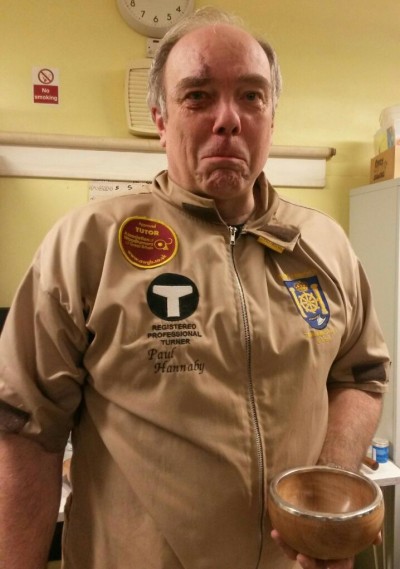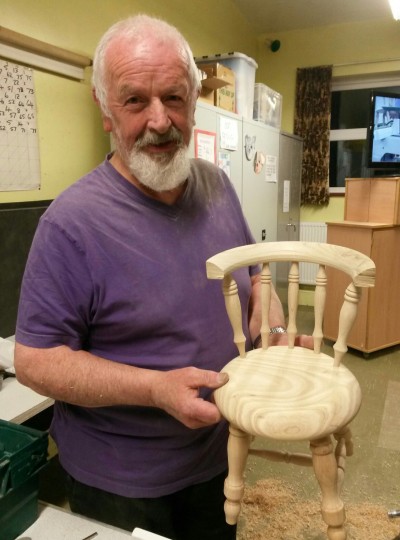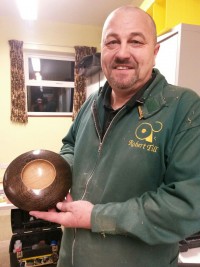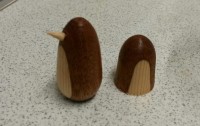Journal of Recent Meetings or Annoucements
Paul Hannaby
Paul demonstrated techniques for working with pewter used in conjunction with wood.
The main part of the demonstration was the production of a bowl with pewter rim.
Some of the key points:-
Wear eye protection and gauntlets when handling molten pewter
An electric metal melting pot with a bottom tap is ideal as this allows clean molten metal to flow into the mould leaving the detritus floating on the surface of the metal in the pot
The pot Paul made use of was (same or similar) Lee Production Pot IV which can be found on Amazon for £88.95 (13th June 2019)
Form a tenon on the rim of the bowl to act as a key. A matching mortice is formed in the pewter rings once cast
To cast ring, using a fine grained material (Paul used MDF) cut a recess of width and depth to suite
When releasing ring from mould remember metal will have shrunk and will threrfore tend to grip inner edge of mould
Once pewter ring is fixed to rim of bowl it can be turned much like turning wood (same tools). Sanding and finishing is also much the same though on light coloured wood care is required not to discolour or scratch wood after abraisives and clothes have been in contact with pewter.
A second part of the demonstration focussed on cutting threads on pewter for use in lidded pots.
Key Points:-
Lathe speed circa 400 rpm
Form 45 degree angle on outer end of male thread
Form a recess at inner end of thread to allow thread cutter to have open space to travel into before lifting away.
Ray Jones
Ray gave us an entertaining and very informative evening.
His demonstration project was the chair shown in the photograph. Through the stages in this project Ray pointed out a number of key points.
- In regards to size and proportion of turned items ask your self "does it look right"
- If making a number of identical or even similar components such as the legs or backrest spindles on a chair get into a "production turning" habit. Prepare the blanks; rough out all the blanks; turn all the components
- For the seat spend time preparing a template to aid marking out
- Roll the tool to turn a bead
- A set of open ended spanners are great for checking spindle diameters when turning
- When rolling a bead put a pencil line where the top of the bead should be. When complete the pencil line should still be there (Just)
- Work out/plan the angles at which holes need to be drilled
Rob Till
Rob gave us a great demonstration on the production and decoration of a "discus bowl".
At the outset of his demonstration, Rob passed round sheets listing the key steps for the two finishes he later demonstrated. This also had a useful list of the finishing products he was using.
During the evening, Rob turned a discus bowl from some fairly dry and dusty oak. Oak was chosen for its open grain.
The upper face of the bowl Rob had turned was treated with Ebonising Lacquer, gold gilt cream and finishing oil (all products from a popular manufacturer). This is the piece pictured.
Rob then did the Blue Peter trick and pulled out a similar bowl and again decorated the upper surface, but this time with spirit stains. A great effect was achieved and, during the process, there were plenty of tips and instructions.
Richard Findley
Richard gave us a first-rate demonstration, turning a short table leg with barley twist.
It was notable how few tools Richard used. This was a lesson in itself.
Richard shared tips and tricks as he worked. At the end of the evening, he passed round the piece of work he had produced with the comment that it needed a bit more work doing to it to be of a standard to come out of his workshop. Members who examined the work with the typical critical eye of a turner looking at another turner's work, were well impressed and struggled to find anything that could be improved.
AGM
This meeting was in two parts.
Firstly the AGM. The meeting was well managed by our Chairman.
The second part of the meeting was a sharpening session. A couple of members brought in their preferred sharpening equipment allowing members to see sharpening techniques, get their tools sharpened, have a go and compare the relative merits of different systems.
Steve Cassidy
Our Chairman Steve Cassidy stood in at short notice and gave us a good demonstration of two projects and what to do when you spill a jar of sanding sealer.
Steve's first project was "penguins". Difficult to judge size from the picture, but these were about 30mm tall. Ideal Christmas decorations.
Steve then went on to make a bowl with an inlay ring. The inlay ring was pre-made from a hard baked putty type material. The challenge Steve then gave himself was to cut a recess in the rim of the bowl such that the pre-made ring was an exact fit to the recess.
Something we all learned from Steve's demo is not to be frightened to have a go at something different or even at standing up front and sharing your ideas.




